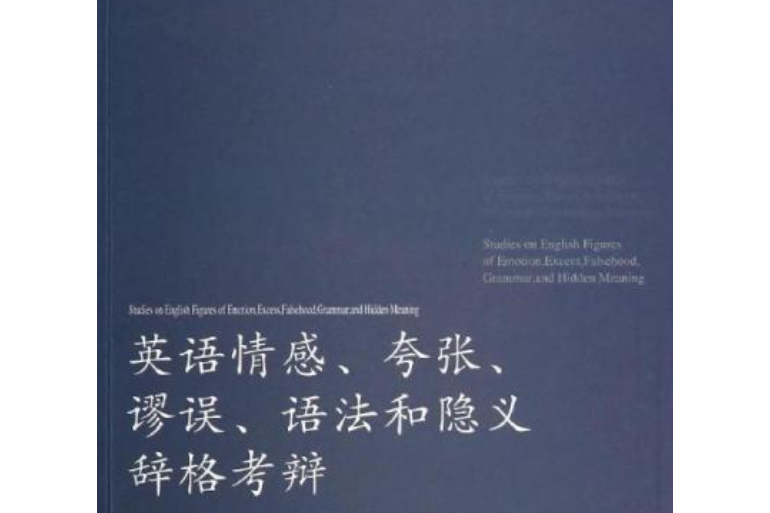《英語情感、誇張、謬誤、語法和隱義辭格考辨》是2014年出版的圖書,作者是韓仲謙。
基本介紹
- 中文名:英語情感、誇張、謬誤、語法和隱義辭格考辨
- 作者:韓仲謙
- 出版時間:2014年6月
- ISBN:978-7-118-09617-0
- 定價:48 元
- 開本:32 開
- 裝幀:平裝
內容簡介,目錄,
內容簡介
作者或說話人常常使用形象化的語言來傳遞語言字面意義以外的意義,以取得特殊的表達效果。各種各樣的修辭格是形象化語言的主要構成手段。英語中除了metaphor、personification等十幾種最常見的修辭格之外,還存在數以百計的另類特殊的修辭格或修辭方法,它們對提高語言文字在各種文體中的表現力發揮著重要作用。全書共分八章,較為詳細地解讀了英語情感類、誇張類、謬誤類、語法類和隱義類特殊修辭格,內容包括定義、例解和用法討論。
本書的讀者對象為英語專業的本科生、研究生和語言研究者。讀者既可以將本書作為一本英語特殊修辭格詞典加以使用,也可以將其作為一本語言學普及讀本加以參考。
下載附屬檔案
目錄
Table of Contents
Chapter 1 Introduction /1
Chapter 2 Figures of Speech in English /6
2.1 Figures of speech as techniques of figurative language in communication/ 6
2.2 Definition of figure of speech/ 7
2.3 History and etymology of the term “figure”/ 8
2.4 Functions of figures of speech/ 9
2.5 Classification of figures of speech/ 9
Chapter 3 Figures of Emotion /13
3.1 Aganactesis / 14
3.1.1 Definition/14
3.1.2 Examples and illustrations/14
3.1.3 Discussion and summary/15
3.2 Asteismus/ 16
3.2.1 Definition/16
3.2.2 Examples and illustrations/16
3.2.3 Use of asteismus/21
3.2.4 Discussion and summary/22
3.3 Anamnesis/ 23
3.3.1 Definition/23
3.3.2 Examples and illustrations/24
3.3.3 Discussion and summary/28
3.4 Apostrophe / 28
3.4.1 Definition/28
3.4.2 Examples and illustrations/29
3.4.3 Discussion and summary/35
3.5 Cacophony/ 36
3.5.1 Definition/36
3.5.2 Use of cacophony/37
3.5.3 Examples and illustrations/38
3.5.4 Discussion and summary/41
3.6 Ethopoeia / 42
3.6.1 Definition/42
3.6.2 Examples and illustrations/42
3.6.3 Discussion and summary/43
3.7 Euche / 44
3.7.1 Definition/44
3.7.2 Use of euche /44
3.7.3 Discussion and summary/46
3.8 Hypocatastasis / 47
3.8.1 Definition/47
3.8.2 Difference between hypocatastasis and metaphor/smile/analogy/47
3.8.3 Use of hypocatastasis/49
3.8.4 Examples and illustrations/50
3.8.5 Discussion and summary/51
3.9 Oeonismos / 52
3.9.1 Definition/52
3.9.2 Examples /52
3.9.3 Discussion and summary/53
3.10 Paraeneticon / 53
3.10.1 Definition/53
3.10.2 Examples and illustrations/53
3.10.3 Discussion and summary/54
Chapter 4 Figures of Excess and Superfluity /55
4.1 Adynaton / 56
4.1.1 Introduction/56
4.1.2 Definition/57
4.1.3 Functions of adynaton/58
4.1.4 Examples and illustrations/58
4.1.5 Discussion and summary/62
4.2 Amphilogy / 63
4.2.1 Definition/63
4.2.2 Examples and illustrations/64
4.2.3 Discussion and summary/64
4.3 Bdelygmia / 65
4.3.1 Definition/65
4.3.2 Use of bdelygmia/65
4.3.3 Examples and illustrations/67
4.3.4 Discussion and summary/69
4.4 Cledonism / 70
4.4.1 Definition/70
4.4.2 Examples and illustrations/70
4.4.3 Discussion and summary/71
4.5 Enumeratio / 72
4.5.1 Introduction/72
4.5.2 Definition/73
4.5.3 Functions of enumeratio/74
4.5.4 Examples and illustrations/74
4.5.5 Discussion and summary/78
4.6 Hyperbole/ 79
4.6.1 Introduction/79
4.6.2 Definition/80
4.6.3 Terminological clarification/82
4.6.4 Realizations of hyperbole/84
4.6.5 Discussion and summary/87
4.7 Optatio / 91
4.7.1 Definition/91
4.7.2 Examples and illustrations/92
4.7.3 Discussion and summary/94
4.8 Periphrasis / 94
4.8.1 Definition/94
4.8.2 Examples and illustrations/95
4.8.3 Linguistic studies on periphrasis/98
4.8.4 Discussion and summary/99
4.9 Perissologia/ 102
4.9.1 Definition/102
4.9.2 Examples and illustrations/102
4.9.3 Discussion and summary/104
4.10 Pleonasm / 106
4.10.1 Definition/106
4.10.2 Examples and illustrations/107
4.10.3 Use of pleonasm/109
4.10.4 Linguistic studies on pleonasm[3]/117
4.10.5 Types of pleonasm[3]/121
4.10.6 Discussion and summary/124
4.11 Syndeton /127
4.11.1 Introduction/127
4.11.2 Definition/127
4.11.3 Use of syndeton/128
4.11.4 Examples and illustrations/132
4.11.5 Discussion and summary/135
4.12 Tautology / 135
5.3.1 Definition/153
5.3.2 Use of antanagoge/154
5.3.3 Examples and illustrations/155
5.3.4 Discussion and summary/156
5.4 Aporia / 157
5.4.1 Definition/157
5.4.2 Use of aporia/158
5.4.3 Examples and illustrations[1]/161
5.4.4 Discussion and summary/168
5.5 Fictio / 169
5.5.1 Definition/169
5.5.2 Use of fictio/170
5.5.3 Examples and illustrations/171
5.5.4 Discussion and summary/173
5.6 Hypocorism / 175
5.6.1 Definition/175
5.6.2 Formation of hypocorism/175
5.6.3 Use of hypocorism /177
5.6.4 Examples and illustrations/179
5.6.5 Discussion and summary/181
5.7 Paradeigma / 181
5.7.1 Definition/181
5.7.2 Examples and illustrations/182
5.7.3 Discussion and summary/182
Chapter 6 Figures of Grammar /183
6.1 Chiasmus / 184
6.1.1 Definition/184
6.1.2 Use of chiasmus/185
6.1.3 Examples and illustrations/187
6.1.4 Difference between chiasmus and antimetabole/193
6.1.5 Discussion and summary/195
6.2 Hypallage / 198
6.2.1 Definition/198
6.2.2 Use of hypallage/200
6.2.3 Examples and illustrations/201
6.2.4 Discussion and summary/204
6.3 Hypotaxis/ 204
6.3.1 Definition/204
6.3.2 Use of hypotaxis/206
6.3.3 Hypotaxis and parataxis/209
6.3.4 Examples and illustrations/211
6.3.5 Discussion and summary/212
6.4 Hypozeuxis / 212
6.4.1 Definition/212
6.4.2 Hypozeuxis and zeugma/213
6.4.3 Use of hypozeuxis/214
6.4.4 Examples and illustrations/214
6.4.5 Discussion and summary/215
6.5 Malapropism / 215
6.5.1 Etymological information/215
6.5.2 Definition/216
6.5.3 Features of malapropism/217
6.5.4 Use of malapropism[1]/219
6.5.5 Examples and illustrations[2]/222
6.5.6 Discussion and summary/235
6.6 Parataxis / 238
6.6.1 Definition/238
6.6.2 Use of parataxis/238
6.6.3 Examples and illustrations/240
6.6.4 Discussion and summary/245
6.7 Polysyndeton / 247
6.7.1 Definition/247
6.7.2 Polysyndeton and asyndeton/247
6.7.3 Use and functions of polysyndeton/249
6.7.4 Examples and illustration/253
6.7.5 Discussion and summary/261
Chapter 7 Figures of Hidden Meaning /264
7.1 Adianoeta / 265
7.1.1 Definition/265
7.1.2 Adianoeta and double entendre/266
7.1.3 Examples and illustrations/267
7.1.4 Discussion and summary/272
7.2 Autoclesis / 273
7.2.1 Definition/273
7.2.2 Similar terms/274
7.2.3 Examples and illustrations/274
7.2.4 Discussion and summary/275
7.3 Homophone / 275
7.3.1 Introduction/275
7.3.2 Definition/276
7.3.3 Use of homophone/276
7.3.4 Homohone, homograph and homonym/278
7.3.5 Causes of English homophone/280
7.3.6 Examples and illustrations/281
7.3.7 Discussion and summary/282
7.4 Paronomasia/ 284
7.4.1 Definition/284
7.4.2 Paronomasia and pun/284
7.4.3 Use of paronomasia/287
7.4.4 Examples and illustrations/289
7.4.5 Discussion and summary/292
7.5 Praecisio/ 293
7.5.1 Definition/293
7.5.2 Use of praecisio (aposiopesis)/293
7.5.3 Types of praecisio (aposiopesis) /294
7.5.4 Examples and illustrations/296
7.5.5 Discussion and summary/297
7.6 Subreption/ 298
7.6.1 Definition/298
7.6.2 Examples /299
7.6.3 Discussion and summary/299
7.7 Synchysis/ 301
7.7.1 Definition/301
7.7.2 Use of synchysis/301
7.7.3 Examples and illustrations/302
7.7.4 Discussion and summary/303
Chapter 8 Conclusion /305
Appendix /308
References /310

